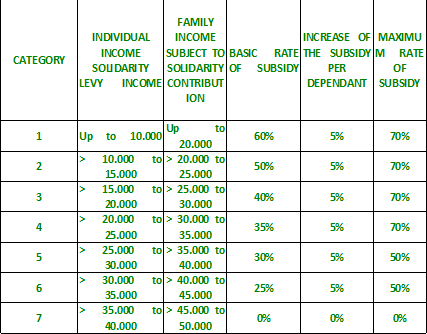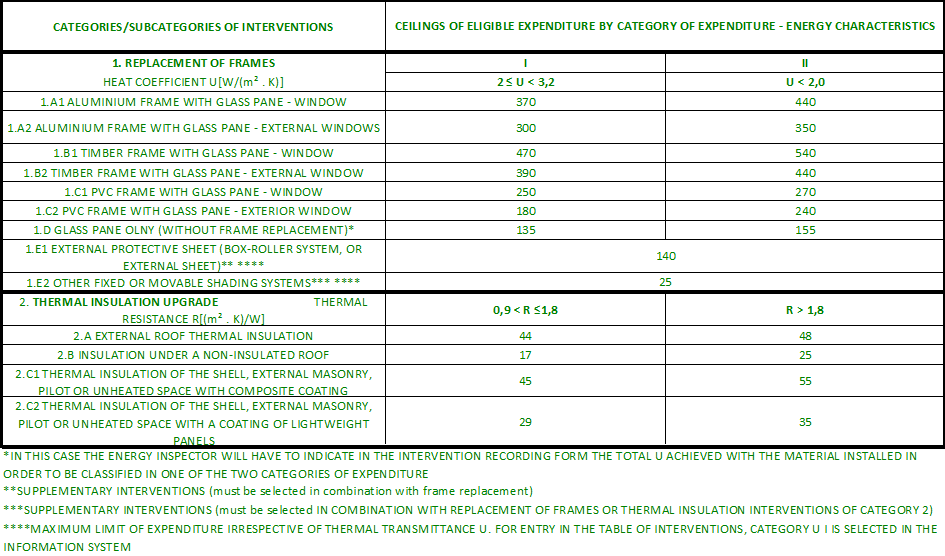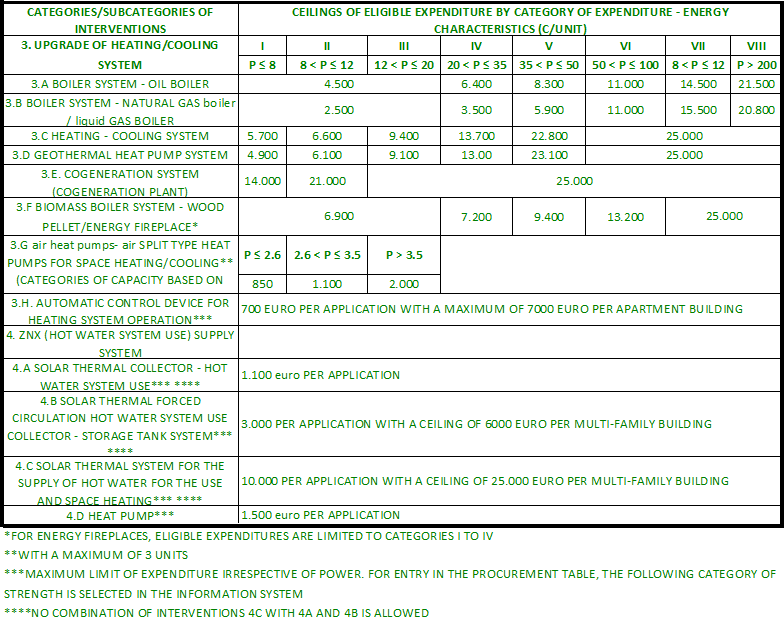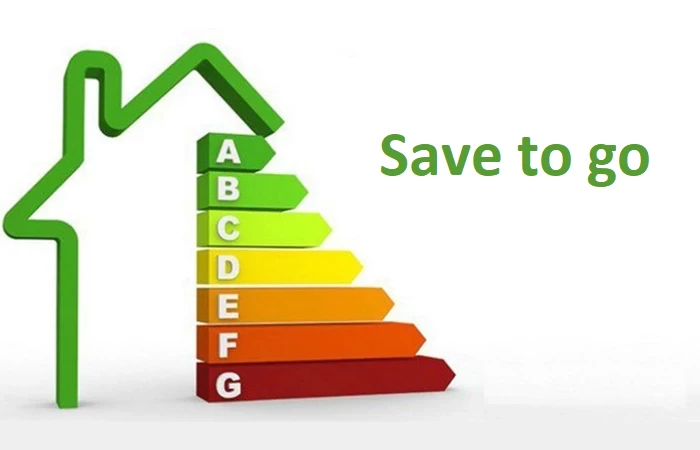The ECO FOR HOUSE 2 PROGRAMM consists in providing incentives for energy saving interventions in the residential building sector, aiming at reducing energy needs. It concerns buildings that have a building permit or other legal document, are used as a main residence and whose owners meet certain income criteria.
Eligible are interventions which are carried out after the issuance of the Energy Performance Certificate of the first energy audit. Part of the interventions may be carried out before the issuance of the inclusion decision, under the sole responsibility of the Beneficiary.
After the implementation of the interventions, the Beneficiaries are contact to an Energy Inspector again in order to have a second energy inspection of their property and a new Energy Performance Certificate (B' Energy Performance Certificate) is issued. According to the B' Energy Performance Certificate and following the finding ascertainment that the energy target has been achieved, the Program incentives are paid to the Beneficiaries.
The cost of the two energy inspections, the cost of the project consultant and any study costs are covered by the Program, provided that the application is accepted and the minimum energy target of the Program is achieved.
Eligible dwellings are detached houses, multi-family houses and individual apartments. Please note that under no circumstances are properties in the building that are not used for residential purposes (e.g., a shop on the ground floor of a building) eligible.
In order to be considered eligible, a dwelling must meet the following conditions:
- It is used as a principal residence, as shown by the information on the most recent (prior to the submission of the application) cleared income tax return (E1) of the person using it.
- It exists legally. If the owner of the dwelling does not have a building permit or if the permit does not correspond to the current state of the dwelling, a legal document showing that the dwelling in question exists legally1 must be provided.
- It has been classified on the basis of the Energy Performance Certificate (EPC) which is issued after 26.11.2017 in a category lower than or equal to D.
- It has not been deemed to be demolishable.
Beneficiaries - Income Categories - Subsidy
Only natural persons who:
- Have a right of ownership (full or fractional) or usufruct in an eligible dwelling.
- Meet the income criteria of the categories in the table below.

The natural persons which are mentioned above, are called Beneficiaries of the Program.
Grant rates refer to the final eligible intervention budget. For the remaining percentage up to 100% of the eligible intervention budget, a loan with an interest rate subsidy may be granted on the basis of a request by the Beneficiary.
In category 7 no grant is awarded but a loan of 100% of the eligible budget and an interest rate subsidy. It is not possible to be included in category 7 without a loan option. It is noted that also for this 7th income category, the costs for the fees of the energy inspector, the project consultant and costs of any studies are covered by the budget of the 'Direct Assistance Program'.
The classification in the categories in the table is based on the income of the last cleared income tax return since the submission of the application.
Only one application must be submitted for each eligible dwelling. The registration in the information system of more than one application for the same eligible residence by the same person or another co-owner will, without exception, lead to the rejection of all applications. Also, in case of an application included in a decision of inclusion, the latter will be revoked.
Eligible interventions - Limits on eligible expenditure
1. Replacement of frames.
Based on the program requirements for energy upgrading, the intervention is essentially the replacement of existing frames (including their removal and the work required for the final configuration of the building element) with double-glazed insulating/thermal break frames. The replacement of the glazing only (including frame adaptation works) is also eligible, provided that an energy upgrade of the frame (existing frame and glazing) above the minimum requirements is achieved. Replacement of front door in a single-family house and staircase and skylight frames in a multi-family house are also eligible. However, "openings" to the interior of the building, whether heated or not (e.g., apartment door) are not included. Supplementary (and not independent) expenditure on fixed or mobile shading systems (awnings, blinds, shutters, etc.) are also eligible in this category.
2. Installation/upgrade of thermal insulation.
In order to provide thermal insulation protection of the building facade, the installation of thermal insulation (external or internal) on the roofing (whether it is formed as a flat roof or as a roof under a non-insulated roof), on the external masonry, as well as on the floor ceiling above an open under floor space (pilot) or another unheated space (e.g., ground floor), covered either with coatings or lightweight plasters, are eligible.
3. Heating/cooling system upgrade.
The installation of a new or replacement of an existing heating system with a new (central or individual) oil/gas/gas/liquefied petroleum gas/biomass/heat pump/CHP system is eligible under this category. The installation/replacement concerns the electromechanical equipment of the boiler room as a whole and the distribution network (automation, circulators, chimney, replacement or insulation of pipes, etc.). Expenditure on the oil tank and terminal heat recovery units (radiators, under floor system, etc.) are not eligible.
4. Heating system by using renewable energy sources (RES).
The installation of a heat pump, a solar system for the supply of domestic hot water and/or to assist the main heating system (collector, water storage tank, support base, piping, etc.) is eligible in this category.
The categories of interventions, their subcategories and the maximum eligible expenditure ceilings, based also on energy characteristics, by category of expenditure are shown in the following tables:


Eligible budget
The eligible budget of interventions per Beneficiary’s application cannot exceed 250€ per square meter of the main floor area of the dwelling, as indicated in the E9 of each apartment/apartment, with a maximum cost of interventions per apartment/apartment of 25.000€, including VAT.
In addition, the following are subsidized by the Program at 100% of the cost, provided that the application is included in the Program and the minimum energy target is achieved:
- The cost required to carry out the two energy inspections.
- The project consultant's fee related to the submission of the application, monitoring the implementation of the energy saving interventions and project completion including the submission of supporting documents until the final disbursement, up to the amount of 248 € per individual application, including VAT.
- The fee for any studies and approvals which are required by the applicable legislation for the proper implementation of interventions (such as, fees for approval of small-scale building works, fees for studies for internal gas installation, etc.), up to an amount of 248€, including VAT.
Coverage of private participation (Equity - Bank borrowing)
Beneficiaries in categories 1 to 7 (see table), depending on their marital status and the number of dependent children, are entitled to the corresponding grant. Either they undertake to pay the balance of the amount with their own funds, or enter into a loan agreement, if they so wish, for the amount they choose or for the amount approved by the financial institution with a 100% interest rate subsidy, or a combination of the above.
Equity capital
This refers to the case where the beneficiary covers the balance beyond the subsidized amount based on the income criteria table with own funds and in case the loan amount is less than the amount of the required private contribution.
In case of covering the private contribution only with own funds, there is no possibility of an advance grant from the program. Therefore, the Beneficiary does not receive an advance from the financial institution, but may make an advance from the amount of equity only through a banking system and irrespective of the number of bank accounts/banking institutions.
After the repayment of the amount of equity (taking into account any advance payment made) and the submission of the relevant supporting documents to ETEAN SA, the grant is disbursed for payment to the contractors/suppliers in their bank account by the financial institution.
Bank borrowing
The interest rate of the loan agreement is 4.00% and is subsidized at 100%. The financial institution will not charge any loan file management costs to the interested parties. The cost of file management, for the applications to be included in the program, is covered by the resources of the ECO FOR HOUSE 2
In addition, the terms of the loan agreement are as follows:
- It is not permissible for the financial institution to require collateral for the loan. Exceptionally, it is allowed, in those cases where citizens wish to do so in order to improve their creditworthiness, in particular in the case of elderly people, minors and people without sufficient personal income, such as, but not limited to, housewives and unemployed persons, to provide a guarantor when applying for the Program.
- The duration of the loan is four (4), five (5) or six (6) years and the interest rate subsidy is for the entire duration of the loan.
- The loan is amortized with monthly installment payments and a fixed interest rate throughout the term of the loan.
- Early partial or total repayment of the loan is possible without any charge to the borrower.
Documents required - Preparation
Any individual wishing to participate in the Program must first verify whether he or she is an "Eligible Beneficiary" and whether his or her property can be considered an "Eligible Home", and arrange for the following:
- Securing passwords to access the TAXIS net application. Please note that it is not possible for individuals who are not certified through the above application and do not have access codes to the application to apply for the program.
- In case there are pending legalization/ regularization issues on the property, they should be settled before submitting the application. Please note that a certificate of completion should have been issued, showing completion of the process of payment of the single special fine for the declared construction or use.
- If there are any outstanding issues in the clearance of the income tax return (E1) or the declaration of real estate data (E9), they must be settled before submitting the application. In case of failure to include the electricity supply number in the above, a data amendment should be made.
- In case of co-ownership rights in the property, the consent of the co-owners should be obtained.
- In case of a condominium application, a decision must first be taken in the general meeting of the condominium. The decisions concern the participation to the Program, to define the interventions that the co-owners wish to implement, to appoint the representative of the condominium and authorise him/her to submit the data and supporting documents required by the Program, and to select the cooperating financial institution to receive loans and/or to pay for the project costs from the grant. Please note that in case of apartment building, all applicants must cooperate with the same financial institution.
Online Application
Applications for funding must be submitted by applicants and must be submitted only through the information system of the official web portal of the Program http://exoikonomisi.ypen.gr.
The commencement date for submission of applications is 28/02/2018 (?). The application concerns the implementation of interventions for the energy upgrade of the applicant's home. Those intervention are proposed by the energy inspector, and the application takes the place of a declaration of commitment.
In order for the application to be considered complete, all relevant fields must be filled in and all supporting documents must be uploaded electronically. Upon final submission of the application, a six-digit electronic protocol number is assigned. Also, the relevant amount for the grant from the Direct Support Program and the loan amount from the ECO FOR HOUSE 2 is committed and the applicant is informed via the information system.
The amount remains blocked for two (2) months from the date of issue of the protocol number mentioned above. Within this period, any procedures for loan approval must be completed or the applicant must decide to "put" the application in "to be included" status without receiving a loan.
First Energy Inspection
Once the applicant has secured the necessary agreements/consents and has verified the eligibility of their residence, they contact an Energy Inspector in order to conduct the first energy inspection of their property/building and issue an Energy Performance Certificate (EPC).
This Energy Performance Certificate must be dated after 26.11.2017. Only the interventions which are carried out after the issuance of the aforementioned Energy Performance Certificate can be considered eligible for the Program (eligibility start date) and until the issuance of the inclusion decision can be carried out under the sole responsibility of the Beneficiary, with the issuance of contractor/supplier cost vouchers on credit.
Start of project implementation - Disbursement of loan advance
After the electronic acceptance of the Submission Decision by the Beneficiary, the Beneficiary is informed electronically about the start of the implementation of the interventions, the deadline for the completion of the project and the obligation to fill in the details of the suppliers / contractors and the designer.
For the start of the implementation of the project, the Beneficiary must obtain the necessary permits required by the applicable provisions.
After the signing of the loan agreement, the Beneficiary is provided with the possibility to disburse an advance of the loan amount corresponding to 70% of the loan amount. The advance is paid to the accounts of the suppliers/contractors (registered in the information system) after relevant order/authorization to the Financial Institution, which is registered by the Beneficiary in the information system.
The disbursement of the advance payment shall be made immediately by the Financial Institution and in any case not later than one (1) week after the payment of the funds to the Financial Institution by the Beneficiary. The Beneficiary shall be informed through the information system for the above advance amount.
Beneficiaries who have not opted for a loan may pay the Contractor/Supplier an advance payment, but only through the banking system.
Issue of documents by the contractors/suppliers/consultant/designer
Eligible for the Program are the expenditure documents on credit, including documents for consultant fees and technical studies. Also eligible are the paid documents which are related to the payment of energy inspector, insurance contributions, payment of own funds which are issued for the purposes of each project after the eligibility commencement date of the Beneficiary's application (date of issuance of the Energy Performance Certificate at the first energy inspection) and within the contractual implementation period.
All expenditure documents of the implemented interventions must be dated before or at most identical to the date of issue of the Energy Performance Certificate of the second energy audit.
In case where a contractor/supplier issues cash register receipts, where it is not possible to indicate the full details of the beneficiary per tax document, the contractor/supplier shall additionally submit a Declaration of Assurance stating in detail, per document, the above required details.
Please note that the expenditure vouchers must have the indication 'private individual' in the occupational details of the recipient of the voucher.
The following are not acceptable:
- Payments made by the beneficiary, with the exception of energy inspector payments, insurance contributions and equity payments (but all through banking system).
- Tax documents which are issued before the eligibility commencement date, regardless of whether they are paid later.
- The payment of expenses in cash or using third party cheques.
- Payments which are made with documents which do not comply with the laws and regulations in force at the time, regulate the framework for carrying out transactions and imposing any restrictions on them
Completion of Interventions - Second Energy Review
After the implementation of the interventions, the Beneficiary or the representative of the apartment building, shall invite an Energy Inspector to carry out the second energy inspection.
The second energy inspection shall establish the energy upgrade of the dwelling and the achievement or not of the minimum energy target as indicated below:
- For income categories 1 and 2, it is required to cover the minimum requirements of the KENAK for each intervention implemented and to achieve annual primary energy savings of more than 40% of the consumption (kWh/m2) of the reference building (before interventions).
- For income categories 3 to 7, the minimum requirements of the KENAK are required to be met for each intervention implemented and to achieve annual primary energy savings of more than 70% of the consumption (kWh/m2) of the reference building (before interventions).
The Energy Inspector, when carrying out the second energy inspection and on the basis of the records of the first Energy Performance Certificate, records for the certification of the physical object, the interventions that have been implemented and meet the requirements of the Program according to the relevant certificates of the materials/systems, the quantity implemented per category of expenditure, the corresponding cost based on the cost documents provided by the Beneficiary as well as the identity of the Energy Performance Certificate issued by the Beneficiary.
The implementation of the physical and financial scope must be completed by the Beneficiary within a period of nine (9) months from the date of issuance of the Acceptance Decision.
Payment of the grant and disbursement of the total amount of the loan shall be completed within a period of two (2) months from the date of submission of the certification statement for completion of the project.
The above amounts shall be disbursed to a bank account of the beneficiary and shall be unconfiscated (including any loan advance). These amounts are reserved for the payment of suppliers/contractors/etc.
Thereafter, payments to contractors/suppliers/etc. shall be made directly by the Financial Institution on the basis of an order/authorization which has been entered to the information system by the Beneficiary. Also, payments must be implemented not later than one (1) week after the funds have been paid to the Beneficiary by the Beneficiary.
Information material, the submission form as well as all the forms in the Guide can be found by the beneficiaries:
- On the official web portal of the Program http://exoikonomisi.ypen.gr
- The NSRF website (www.espa.gr)
- The Beneficiary's website (www.etean.gr).

